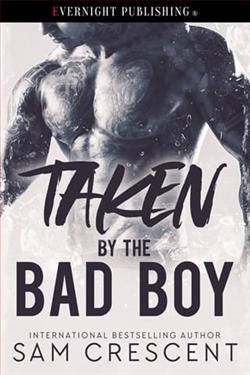Page 52 of Experimental Film
“Well . . .” Malin pulled up some sort of further breakdown, fast-forwarded till something caught her eye, stopped. Under the window showing the footage, the sound mix drew multiple jagged, oscillating vector lines across a black field, each in its own colour. Malin pointed to one almost flat line at the bottom edge of the field, then another, wavering in and out of visibility, right at the top. “Here; this, these. There’s—something, up and down, just around the outer edges of what the mic would be picking up. Between the range and the volume, it makes sense you wouldn’t have heard it. But I’ve got pretty good ears.”
“Good thing, given your line of work.”
“It’s useful, that’s for sure. Let me see what I can pull out.” Safie looked at me again; I nodded. “Okay, now . . . it probably won’t make much sense, ’cause I’m going to have to really push it to make it audible, and besides, it’s gappy as heck. . . .”
“Go for it.”
She did as asked, lip between her teeth, keyboard and mouse rapidly clicking. All the lines but the two she’d pointed out vanished, and those two then stretched out vertically, like scars straining over skin pulled tight. With a flourish, Malin pulled her headphone jack out and clicked PLAY, the white tracking cursor sliding smoothly from left to right. What came through the speakers sounded like something taken from deep underwater, all hiss and click and slosh. Plus a sort of—well, what sounded like a long, low, intermittent tone, echoing up through muddy fathoms.
“Is that a bell?” I asked Safie, who shook her head, equally baffled.
“That’s about as good as it’s going to get,” Malin told us. “Sorry.”
“Still kind of obscure,” Safie agreed. “Could you convert it into something else, though? Data—an image, maybe?”
Malin frowned. “What, like a graphic? I’d need something capable of extracting visuals from a sound-recording medium.”
“Do you have a recorder? For cassette tapes, I mean.”
“Yeah, sure, somewhere—the system’s computerized, but I can plug in pretty much any tech I want; you have to, when you’re doing reconstructive and transfer work.” She got up, went to the green metal shelving on one wall and began sliding white banker’s boxes out to look through them. “You want reel to reel, mini, what?”
“Compact, magnetic tape, analog signal, C-30 or -60. An old-style mix-tape, basically.”
“Why?”
Safie opened her mouth, but right at that very moment I snapped my fingers, finally getting it.
“PixelVision,” I said, out loud.
You are under Her eye, the Kantorka told me, and thus whatever you make will be touched by Her likewise, always open to her looking and working through it, working Her will on this world; every thing you fashion will be both a mirror and a door, especially during Her hour.
I thought I k
new what she spoke of; but how could I, when I did not yet know of Hyatt’s very existence? My poor boy, born between the minute and the hour, who felt Her burning hand on his head even inside my belly?
It is always midday somewhere in the world, however, both day and night. And so the Lady’s limits truly have no limit.
If I had never agreed to go to Dzéngast then we might have lived out our lives in peace, he and I and Arthur, too, for my sins. Arthur knew no better, after all, in begging me to go there, to make my peace, solve my riddle. To stare my father’s crime down and spend the rest of my days praying to Christ and his father, like a civilized woman, not staying forever some weak slave of those old, bloody gods in whose names I was first baptized. . . .
He knew no better, my husband, and I know it; he loved me, as he loves me still. He wanted only my betterment, as he wants Hyatt’s, never willing to acknowledge him broken since before birth, let alone vowed to another Supreme Being entirely.
Art knew no better, poor man. But I did, even then.
I did.
When Safie brought her PXL-2000 in from the car, Malin’s mouth fell open. “Holy shit, seriously? I haven’t seen one of those in . . . actually, I don’t think I’ve ever seen one of those. You got a cassette already?”
“Never leave home without it,” Safie told her. “I’ve been recording over this one for, like three years now, watching it degrade: sound to vision. All we have to do is put the sound on the tape, hook the camera to a monitor, FireWire in the computer, and we can burn the footage right off the screen.”
“Handy,” Malin said, approvingly. “Okay, let’s set ’er up.”
I went to the toilet while they assembled the machinery, leaning against the wall for a moment, forehead slick on cool tile. The static of the day was starting to mount in my head, and I could feel my pulse like a nervous tic in my temples; not painful yet, but uncomfortable, like I’d drunk too much coffee and was right on the edge of a caffeine headache. But even that was weirdly exciting.
By the time I came back out, things were ready to roll.
“Here we go,” Safie said, slipping in the tape as I sat back down.
It started like every PixelVision film I’ve ever seen—snow on snow, progressively dirtier. Long bars more than individual points, gradients of grey; it’s like watching something on a really old videotape, or a slightly scrambled channel, or a dial-and-antenna TV whose picture tube is giving out. Except here, there wasn’t even a 1920s cartoon version of me to focus on, or the glass house’s broken panes, the background flats I’d been flipping through—no sort of image at all, just an ebb and flow of grain, as if someone had left the camera angled on one of those fly-blown, dust-crusted mirrors Mrs. Whitcomb once set up to maximize the light for shooting.















